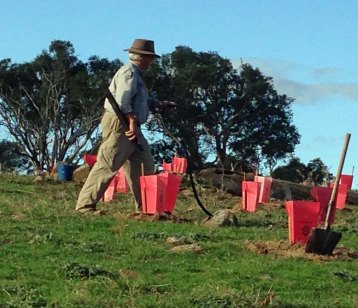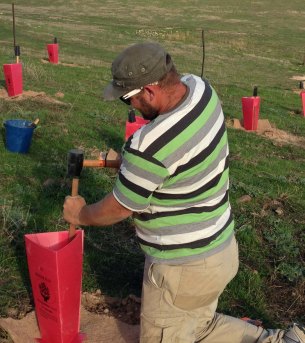Last weekend we planted in two different directions at once. 

We finished the final small tree lots that are part of the chain of connections across the Murrumbidgee river for small birds. That makes nine tree lots for connectivity only, plus two extra areas, a shelter paddock that used to be a calf-feeding area, and a decorative one that will have an avenue of white trunked eucalyptus mannifera at the entry to Adnamira . The two extras will act as bird stepping stones as well.

We also created our first link in a second chain that will run along the river from Burrinjuck to Canberra to encourage the tiny local populations of Glossy Black Cockatoos (Calyptorhynchus lathami) to meet up and repopulate.
That meant that the final small tree lot, coming down to a dam on Adnamira, was planted not only with our usual broad mix of locally sourced native trees and shrubs for the small birds, but also with 100 Allocasuarina Verticillata (the Drooping Sheoak) given to us by Greening Australia for the purpose.
Along the river banks we have lots of Casuarina Cunninghamiana (the River Sheoaks). They’re one of the few native trees that seeds and shoots up quickly enough to outpace the munching of the sheep and kangaroos. But Glossy Blacks don’t eat their seeds.
According to Ben Hanrahan from Greening Australia the rocky hills in his area used to be covered with Drooping Sheoaks as well as the eucalypts we can see in remnants. It’s mind-bending that something so widespread could disappear so thoroughly.

Unlike the river casuarinas, allocasuarinas grow very slowly in the first few years. We planted a few in 2011 and they sat at about 30cm (1 foot) tall for nearly three years. A few times I thought some of them had died, but they still had a wispy green needle or two sticking up. Suddenly in the last twelve months they’ve shot up, but had they not been protected from stock that would have been far too slow. They also only live about forty years, so they need to be able to reproduce regularly. Since I didn’t know they came in male and female, we scattered those 2011 seedlings rather widely and they may not be close enough together to breed successfully.
So we needed to add more.
As the Drooping Sheoaks have disappeared over the last 200 years, so have the Glossy Black Cockatoos. Like a picky toddler, they only eat that one thing in this area. Further north, and along the coast they have a few different choices, but they’re all allocasuarinas of one sort or another. They’d literally rather die than eat anything else.
On one side of the river we planted those 100 Drooping Sheoaks.
On the other side, Greening Australia is organizing the planting of 300 more on another rocky hillside that I have yet to get fenced in. My excellent fencer is a bit daunted by the steepness and rocks. Greening Australia also have other plots near the river that should make a series of stepping stones for the Glossy Blacks.
If the birds look for them.
If they find them.
Mum asked “Why are you going to so much trouble for one bird?”
It’s a good question.
Ben Hanrahan told me that the population they know of at Burrinjuck contains just eight individuals. The closest population around Canberra has perhaps 24. In many ways it’s hard to know what the Glossy Blacks contributed to the landscape back when they were more widespread. If we let them die out, we’ll never know.

 George Main from the National Museum of Australia who kindly volunteered to help us plant the Drooping Sheoaks remembered propagating them as a child, and finding by trial and error that they don’t grow well in the boggy riverside spots that River casuarinas prefer.
George Main from the National Museum of Australia who kindly volunteered to help us plant the Drooping Sheoaks remembered propagating them as a child, and finding by trial and error that they don’t grow well in the boggy riverside spots that River casuarinas prefer.
I’m hoping they like the place we’ve given them, on a rocky, windy ridge. Just right for a cockatoo snack bar.


Here’s a SMH article that I think you would find interesting. Also talks about having theove along Galahs http://m.smh.com.au/technology/sci-tech/renovators-called-in-as-housing-crisis-hits-picky-birds-20150626-ghwkmw
LikeLike
Wow. That’s fascinating. If we had to do external boxes (because we don’t have enough of large enough trees) it would certainly help to insulate them. Maybe build them out of something thick like old wooden fence posts.
I’m interested that the galahs may have moved in in place of the missing cockatoos. We had one dead tree that one spring had a galah head popping out of each of twenty holes. I read somewhere that they were originally identified only up in northwest NSW, but now are common everywhere. We get huge flocks. It can be impressive watching the galahs wheeling back and forth over the river, flashing pink one way, grey the next.
Still thinking about nesting boxes – we could also cut hollow trunks from the dead fallen trees that haven’t rotted out too much yet. It’d be interesting to know what height the glossy black cockatoos like. If the boxes are heavy, it’s not going to be easy to put them up high. Hmmm.
LikeLiked by 1 person
Saving one bird might save an ecosystem. Congratulations and best of luck to the glossy black cockatoos.
LikeLike
Yes, who knows what they got up to when there were lots of them?
LikeLiked by 1 person
Nice job. Really inspiring work and I hope this part results in more glossy blacks. Any plans to add some nest boxes or man made hollows for potential nesting spots down the track?
LikeLike
Thanks. That’s a really interesting thought. I hadn’t got that far yet. We do have quite a few old trees with hollows, but it’s interesting that the parrots (mostly galahs that I’ve noticed) used one in particular much more readily when it was surrounded by other greenery rather than when it was alone in a paddock. Nesting boxes are a good idea. I like the idea of being able to (carefully) check out what’s happening inside. I’ll have to see if I can find some suitable measurements, and then let loose Craig’s dodgy carpentry skills.
LikeLiked by 1 person
No problems. I wonder if anyone has ever worked out what the most suitable nesting box shape and entry size is for this species? I noticed that one technique these guys use is to use chainsaws to cut and make hollows in existing trees that have been loped back or in stumps. Could be worth thinking about. https://www.facebook.com/urbanhabitatcreation .I look forward to following the update on it all :). Lachlan @fishthinkers
LikeLike
Fiona, I’m in awe of your continuing efforts! I just saw Salt of the Earth (documentary by Wim Wenders about Brazilian photographer Sebastiao Salgado), and if you haven’t seen it, you must – he took on a project like yours, replanting a large denuded area on his father’s farm in Mina’s Gerais with original native trees and vines, very inspiring, as the film is meant to be.
I hear there is going to be a visit to California soon (Congratulations, Charles!) – hope you make it to the Bay Area. Best, Candida
LikeLike
Hi Candida, thanks for your kind words. We’re not just coming to California, but to Brazil as well. I’ll have to look at the documentary.
LikeLike